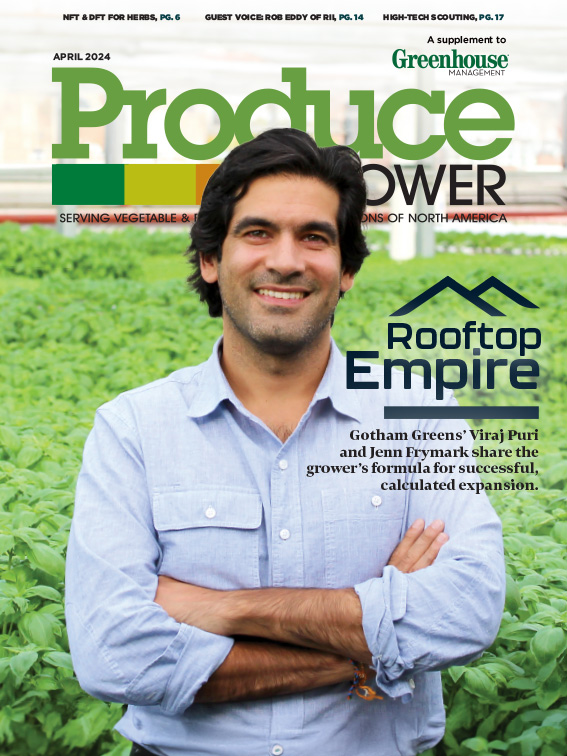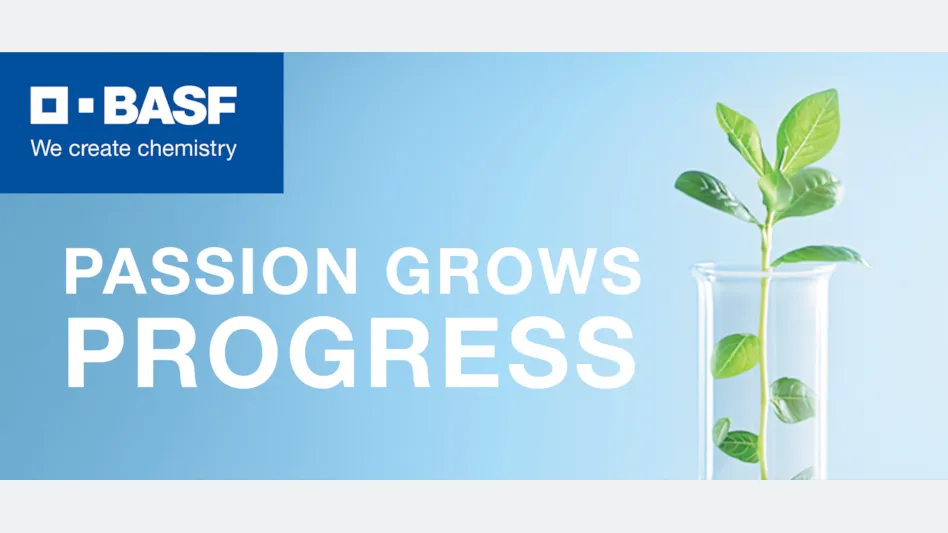Controlled environment agriculture (CEA) represents a paradigm shift in agriculture. Food producers can leverage greenhouses and indoor farms to grow fresh produce year-round and fill the needs of communities in food deserts while offering their crops a controlled and optimized growth environment.
From high-efficiency mechanical cooling systems and supplemental or sole-sourced LED lighting to automated controls and CO2 supplementation, growers have more tools than ever to control the quality of their crops’ environment. However, the conventional wisdom of maintaining strict environmental setpoints that push plants to their production limits may inadvertently lead to inefficiencies in resource utilization.
Instead, growers can unlock new opportunities for resource efficiency and crop steering by embracing a more nuanced approach that involves tracking environmental parameter averages daily or over several days.
In this first column for Produce Grower, we explore how this mindset shift can lead to more resource-efficient and economically resilient operations.
Economic rationale
“There are a lot of studies that are coming out that say the tighter you can hold the averages, the better growth you get,” says Mike Zartarian, principal at RII member Zartarian Engineering. That said, “The tighter the control that you want, the more energy it’s going to take to achieve that.”
Certain high-value commercial agriculture crops might be worth the costs associated with the additional inputs that can be delivered in indoor farms or greenhouses optimized for production, but in most food crops, every watt and cent counts. When making environmental control crop steering decisions, growers should look at both energy efficiency (yield weight/watts) as well as productivity (yield value/watts) to determine whether the gains from any additional inputs add value to the crop.
“From the lighting and HVAC standpoint, some of these cultivation facilities [are] really designed for optimal performance, especially in the cannabis space,” says Chip Seidel, director of business development at RII member Desert Aire. “If you’re growing basil or leafy greens, there’s a way to use that technology but dial it back a little bit and dramatically reduce the amount of energy you’re using and the amount of wear and tear on your equipment.”
For example, a controller for a mechanically cooled greenhouse growing tomatoes set to maintain a temperature of 80°F with a deadband of 5°F will activate cooling systems when sensors signal an air temperature of 85°F. But what if the previous three days had unseasonably cool temperatures, and the greenhouse temperature averaged 75°F during those days? A controller that considers historical average environmental data may delay activating HVAC systems until those higher temperatures persist for a set amount of time. This saves on equipment short-cycling, which can generate higher energy costs and increase wear on HVAC systems (although some high-performance HVAC systems are designed to manage these constant on-off cycles).

System adjustments to consider
Greenhouse operations are much better suited to use an average-based approach to environmental controls because there exists a natural variation both inside and outside the structure. Indoor farms are much more tightly controlled as they rely exclusively on artificial lighting and mechanical cooling to maintain crop environments, while greenhouse conditions fluctuate with daily outdoor conditions. The principles presented here can still be adapted for indoor farms.
Humidity lighting
Rather than adhering rigidly to predefined light intensity and duration settings, tracking lighting parameter averages allows growers to adapt dynamically to changing environmental conditions and crop requirements. By analyzing daily light integral and light intensity trends, greenhouse growers can optimize resource use efficiency by aligning supplemental lighting schedules with periods when plants will utilize it most. Lighting is most effective during low sunlight, when the light reactions limit photosynthesis. During bright weather, photosynthesis can only be increased with higher temperatures or CO2 concentration.
Furthermore, if the previous day accumulated an “excess” of light above DLI target, this “DLI carryover” can be added to the current day’s DLI calculation, effectively reducing the time the supplemental lighting operates. The late researcher Marc van Iersel noted in a 2022 Greenhouse Management report that this DLI carryover method “can result in savings anywhere from $6,000 to $9,000 per acre per year.”
The most recent advance in smart lighting is using historical weather data to predict the net 3-7 days DLI to further refine the lighting operations. By leveraging natural light fluctuations and supplementing with artificial lighting only when necessary, growers can minimize reliance on energy-intensive lighting systems, thereby reducing operational costs and environmental impact.

“There are cloudy days out in nature,” Zartarian notes. “It’s more about the total amount of light that the plant gets in its lifetime or during its major stages of growth than it is about getting the precise amount on any given day.”
While maintaining precise humidity setpoints is important for preventing moisture-related issues, tracking humidity parameter averages offers a more nuanced approach to resource management. By monitoring trends in humidity levels and fluctuations, growers can implement targeted interventions to optimize resource utilization while safeguarding crop health.
Similarly, rather than continuously dehumidifying to maintain a specific setpoint, growers can strategically adjust ventilation and irrigation systems based on real-time humidity data. This reduces energy consumption associated with dehumidification and minimizes water usage by aligning irrigation schedules with actual plant transpiration rates. Irrigation and fertigation also are more cost-effective to tightly control compared to temperature and humidity. (For more information on water efficiency and circularity systems in CEA environments, download RII’s free Water Circularity Best Practices Guide at bit.ly/water-circularity.)
Moreover, by embracing natural fluctuations in humidity and temperature levels and their relationship to vapor pressure deficit (VPD), growers can enhance resource efficiency while promoting optimal plant growth. “Say you want a VPD of 1.4. That can be achieved at a bunch of different temperatures and different relative humidities,” Seidel explains. “If your temperatures are going up … as long as you keep your relative humidity under control, you can just match that up with whatever the RH would need to be at that higher temperature to keep you at the same VPD.”

Temperature
Temperature management is critical for ensuring optimal plant growth and metabolic activity. However, rather than adhering strictly to predetermined temperature setpoints, tracking temperature parameter averages allows growers to capitalize on natural thermal dynamics.
By monitoring temperature trends and fluctuations, growers can implement dynamic heating and cooling strategies that align with plant developmental stages and environmental conditions. For example, during periods of high ambient temperatures, growers can leverage natural ventilation and thermal mass to passively regulate internal temperatures, reducing reliance on energy-intensive cooling systems.
“A lot of times, lights are really strong, and they’ve just turned on, and the plants are not transpiring yet, and your temperatures can start to creep,” Seidel shares. “But if you wait just a little bit, what you’ll see is the plants will start to transpire, and you’ll get all that benefit of the evaporative cooling from the transpiration. So sometimes, it’s a benefit to not have a knee-jerk reaction and overcorrect right away” with mechanical systems.
Temperature integration is another best practice to reduce energy consumption in a greenhouse setting where the ambient environment changes hourly and daily, as detailed in RII’s forthcoming publication, “Best Practices: Controls & Automation.” In this practice, both current and recent historical climate data are used to determine setpoints and control temperature. For example, a 24-hour, 48-hour or even 72-hour average reading is used by the controller, rather than instantaneous measurements alone. During hot summer days, the night temperature may be adjusted lower to maintain the average temperature close to the target setpoint. This would typically save heating energy at night.
By embracing natural fluctuations and dynamic feedback mechanisms, growers can optimize resource utilization while maximizing crop productivity and sustainability. As the CEA industry continues to innovate and refine its practices, the synergy among resource efficiency, crop steering and environmental sustainability will remain paramount in shaping the future of food production.

Explore the April 2024 Issue
Check out more from this issue and find you next story to read.
Latest from Produce Grower
- DENSO and Certhon introduce Artemy, a fully automated cherry truss tomato harvesting robot
- Landmark Plastic celebrates 40 years
- CropLife applauds introduction of Miscellaneous Tariff Bill
- UF/IFAS researchers work to make beer hops a Florida crop
- Nature's Miracle announces initial shipments of "MiracleTainer" series container farm
- Local Bounti opens new high-tech controlled environment agriculture facility in Pasco, Washington
- NatureSweet responds after ruling by U.S. Court of International Trade that invalidates tax on tomato imports from Mexico
- Former Danone executive becomes chief operating officer at NatureSweet





